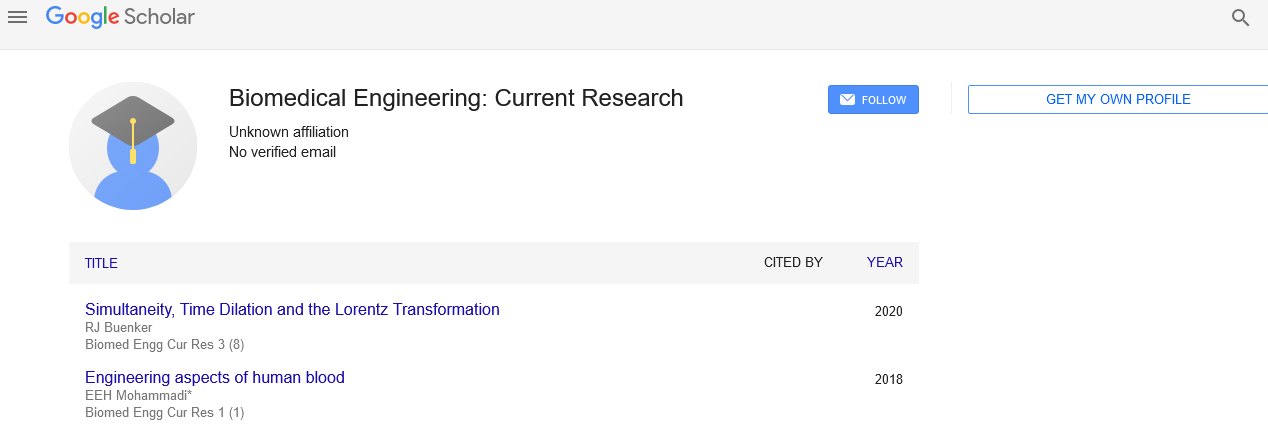Use of telemedicine's advantages for disease management
Received: 03-Jun-2022, Manuscript No. pulbecr-22-5161; Editor assigned: 05-Jun-2022, Pre QC No. pulbecr-22-5161 (PQ); Accepted Date: Jun 20, 2022; Reviewed: 18-Jun-2022 QC No. pulbecr-22-5161 (Q); Revised: 19-Jun-2022, Manuscript No. pulbecr-22-5161 (R); Published: 26-Jun-2022, DOI: 10.37532/PULBECR .2022.4(3).14-15.
Citation: Tump D. Use of telemedicine's advantages for disease management. J Biomed Eng: Curr Res. 2022;4(3):14-15.
This open-access article is distributed under the terms of the Creative Commons Attribution Non-Commercial License (CC BY-NC) (http://creativecommons.org/licenses/by-nc/4.0/), which permits reuse, distribution and reproduction of the article, provided that the original work is properly cited and the reuse is restricted to noncommercial purposes. For commercial reuse, contact reprints@pulsus.com
Abstract
Delivering medical care and swapping medical information over long distances are appertained to as telemedicine. To put it simply, telemedicine is a drug performed ever because the prefix" tele" comes from the Greek for" at a distance." As a result, it covers the entire diapason of medical operations, similar as complaint opinion, treatment, and forestallment, ongoing training for consumers and healthcare professionals, and exploration and evaluation. The provision of nursing and community support to a case across a distance is known as telecare, an affiliated word. The provision of public health services over vast distances to those who are not inescapably bad but want to lead healthy, independent lives is also known as telehealth. still, in practice, despite repeated conversations about what constitutes telemedicine, telecare, and telehealth and what their differences are, all involve the transfer of information about health-related issues between one or further spots to ameliorate the health of individuals and their communities. To put it another way, information is dislocated, not healthcare interpreters or cases.
Keywords
Telemedicine, Pathology, Technology
Introduction
Delivering medical care and swapping medical information over long distances are appertained to as telemedicine. To put it simply, telemedicine is a drug performed ever because the prefix" tele" comes from the Greek for" at a distance." As a result, it covers the entire diapason of medical operations, similar as complaint opinion, treatment, and forestallment, ongoing training for consumers and healthcare professionals, and exploration and evaluation. The provision of nursing and community support to a case across a distance is known as telecare, an affiliated word. The provision of public health services over vast distances to those who are not inescapably bad but want to lead healthy, independent lives is also known as telehealth. still, in practice, despite repeated conversations about what constitutes telemedicine, telecare, and tele-health and what their differences are, all involve the transfer of information about health-related issues between one or further spots to ameliorate the health of individuals and their communities. To put it another way, information is dislocated, not healthcare interpreters or cases.
Telemedicine is neither a new technology nor a distinct or brand-new area of drug. Also, it's neither a result of all of the world's medical issues nor a way to exclude the need for healthcare professionals. It's also not a hobbyhorse for bible exists or Luddites, who can range from people who are simply uncomfortable using electronic bias to those who believe that telemedicine threatens the entire foundation of the practice of drugs and should be laboriously fought. still, it isn't just the sphere of" crackers" or computer nerds. On two fronts, the recent advancement of telemedicine has been made possible.
First, there are advancements in electronic communication ways. Analog approaches were originally employed, but ultramodern digital communication technologies are now the norm. Second, telemedicine has evolved as a result of the early work of a select group of institutions and people. In general, the former represented the interests of high-tech enterprises, including the mortal space flight program of the National Aeronautics and Space Administration (NASA) in the USA. The sweats of a small number of people exercising extensively available marketable outfits have maybe been just as significant for the development of telemedicine, indeed though these were irrefutable of tremendous value in promoting the growth of telemedicine and telecommunications in general. Although much attention has been paid to the use of interactive video for specialist and subspecialty consultation in rural locations, the therapeutic uses of telemedicine are even more diverse than the technologies. In order to connect a rural hospital with an urban tertiary care center, the general interactive video telemedicine system often requires fixed, studio-style video equipment. Consultants interact with patients and frequently with the patients' primary care doctors. The specific arrangement of these networks varies, ranging from simple "hub-and-spoke" networks with a few referring and consulting facilities to sophisticated "hub-and-spoke" networks with many (for example, a university medical center) as a single source of referrals and consultants.
Predicting the role of telemedicine in future practice is challenging due to the rapid developments in technology and healthcare. By using a desktop workstation or laptop computer in a mobile, wireless setup, it is predicted that medical professionals will be able to see patients at distant locations over the next several years. The interactive video and store-and-forward modes will be available for clinicians to choose from as needed. Simple, clear digital interfaces will make it simple to obtain relevant patient records, radiographs, pathology slides, pharmaceutical data, and billing records. There will be immediate access to medical informational databases, diagnostic and therapeutic algorithms, and patient education resources online.





